The luxury watch market in 2025 has matured into a sophisticated landscape where discerning collectors can access exceptional timepieces without reaching the stratospheric prices of ultra-high-end brands. With entry-level luxury pricing now settling around the $8,000 threshold and a growing appreciation for heritage brands over speculative pieces, the sub-$10,000 segment offers compelling opportunities for both newcomers and seasoned enthusiasts. This comprehensive guide examines the finest luxury watches available under $10,000, focusing on models that combine exceptional craftsmanship, brand heritage, and strong value propositions for collectors seeking their first serious timepiece or expanding their existing collection.
Understanding the Modern Luxury Watch Landscape
The luxury watch market has experienced significant evolution in recent years, with global valuations reaching approximately $72 billion and projecting sustained growth through 2030. What makes this particularly relevant for new collectors is the market’s shift toward fundamental value drivers: brand integrity, scarcity, and long-term retention rather than speculative trends.
Several key factors have reshaped the sub-$10,000 segment. First, major manufacturers have strategically repositioned their entry-level offerings, moving from the traditional $5,000 baseline toward $8,000, but delivering substantially improved quality and features at this new threshold. Second, younger collectors are increasingly drawn to watches that offer both emotional appeal and practical investment potential, favoring pieces with documented heritage over purely trendy models.
The secondary market has also matured significantly, with established platforms providing authentication services and price transparency that benefit both buyers and sellers. This development has made luxury watch ownership more accessible while ensuring that quality pieces maintain their value proposition over time.

Five-year value appreciation performance of luxury watch brands from 2019-2024, showing how different manufacturers have performed in the secondary market
Top Picks: The Finest Luxury Watches Under $10,000
Omega Speedmaster Professional Moonwatch
The Omega Speedmaster Professional stands as one of the most significant achievements in horological history, earning its legendary status not through marketing but through authentic accomplishment. Introduced in 1957 as part of Omega’s “Professional” trilogy, the Speedmaster was originally designed for motorsport applications, featuring the innovative tachymeter bezel that moved the scale from the dial to the outer edge.
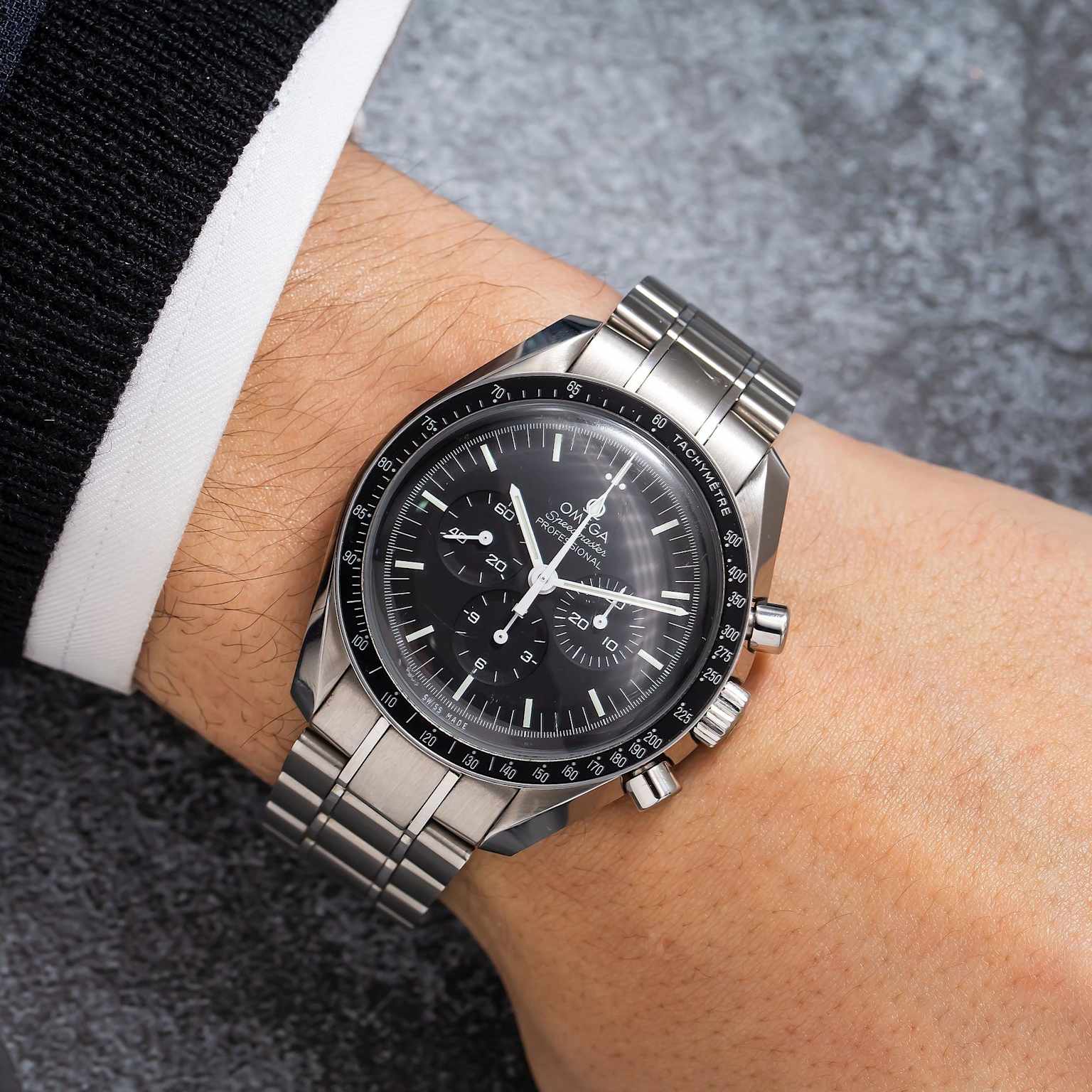
An Omega Speedmaster Professional Moonwatch with a black dial and steel bracelet, one of the top picks for luxury watches under $10,000
The watch’s trajectory changed dramatically when NASA selected it for space missions after rigorous testing in the early 1960s. The Speedmaster became the first watch worn on the moon during the Apollo 11 mission in 1969, when Buzz Aldrin wore his Speedmaster on the lunar surface. This achievement wasn’t merely ceremonial—the watch had proven its reliability under extreme conditions including high G-forces, vacuum, shock, and temperature fluctuations.
Key Specifications:
- Case Material: Stainless steel with brushed and polished finishes
- Movement: Manual-winding Caliber 3861 (Master Chronometer certified)
- Case Size: 42mm diameter, appropriate for most wrist sizes
- Functions: Chronograph with 30-minute and 12-hour registers, small seconds
- Water Resistance: 50 meters (suitable for daily wear)
- Price Range: $4,000 – $8,500 depending on configuration
The modern Speedmaster maintains the essential DNA of the original moon watch while incorporating contemporary improvements. The current Caliber 3861 movement offers enhanced precision and anti-magnetic resistance up to 15,000 gauss, significantly improving everyday reliability. The hesalite crystal option preserves the authentic vintage aesthetic, while sapphire crystal versions provide superior scratch resistance for daily wear.
From an investment perspective, the Speedmaster Professional offers exceptional value retention due to its historical significance and continued NASA certification. Limited editions and anniversary models frequently appreciate beyond retail pricing, while standard production models maintain steady value in the secondary market.
Cartier Santos de Cartier
The Cartier Santos holds the distinction of being one of the first purpose-built wristwatches, created in 1904 for aviation pioneer Alberto Santos-Dumont. Louis Cartier designed this revolutionary timepiece to address Santos-Dumont’s practical need for hands-free timekeeping during flight, when pocket watches proved impractical in aircraft cockpits.
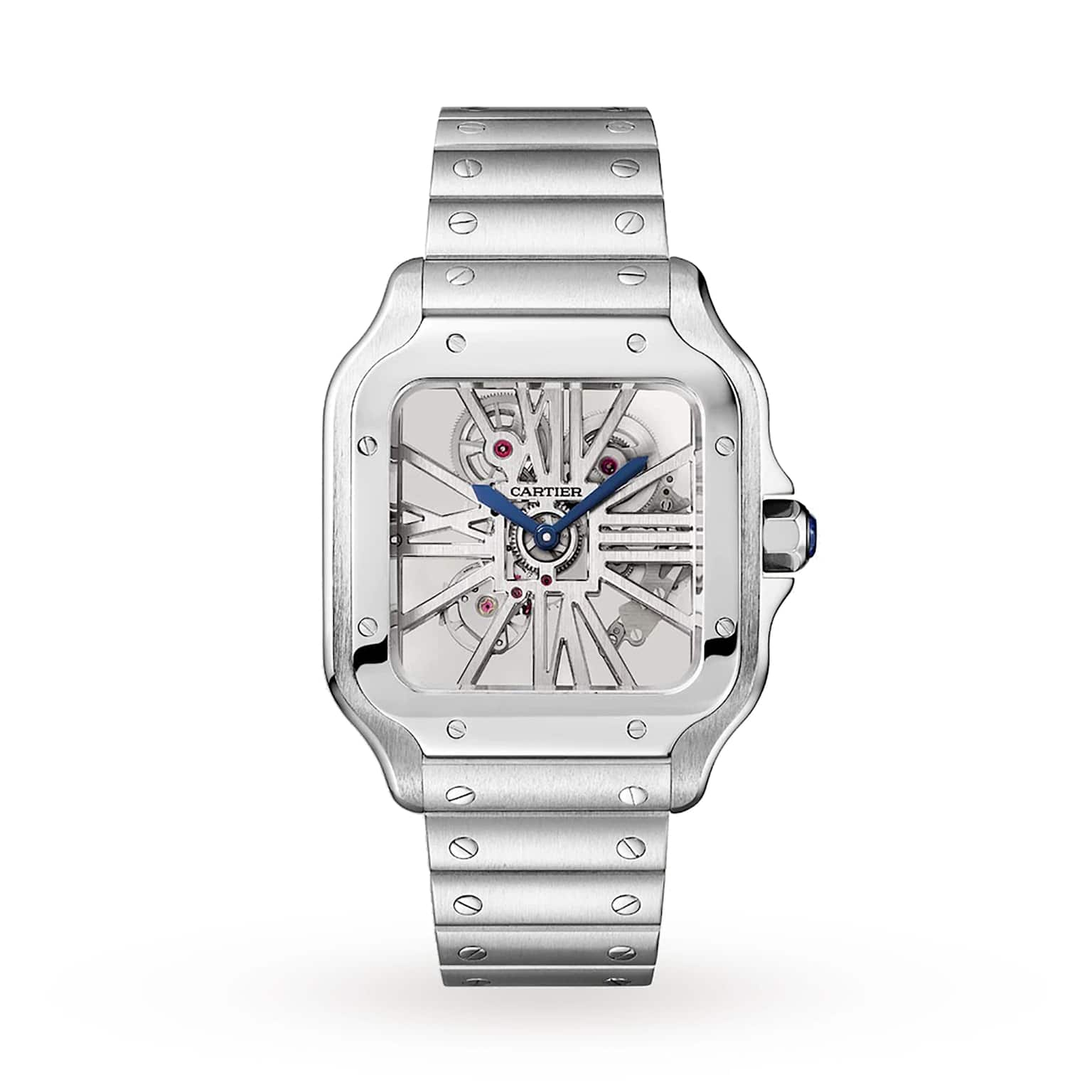
A stainless steel Cartier Santos de Cartier Skeleton watch featuring its distinctive square case and intricate openworked dial
The Santos introduced several groundbreaking design elements that remain iconic today. The square case with rounded corners was a bold departure from traditional round pocket watches, while the exposed screws on the bezel served both functional and aesthetic purposes, reflecting the industrial spirit of early aviation. The watch featured Roman numerals for enhanced legibility and a leather strap—revolutionary for its time—that provided comfort and security during active use.
Key Specifications:
- Case Material: Stainless steel or steel/gold two-tone construction
- Movement: Automatic Caliber 1847 MC (in-house manufacture)
- Case Size: 39.8mm x 35.1mm (large model), ideal for contemporary preferences
- Functions: Hours, minutes, seconds, date
- Water Resistance: 100 meters (suitable for swimming)
- Price Range: $6,000 – $8,500 for steel models
The modern Santos de Cartier collection, refreshed in 2018, incorporates contemporary innovations while preserving the original’s distinctive character. The QuickSwitch system allows effortless strap changes, while the SmartLink bracelet offers tool-free adjustment—practical features that enhance daily usability.
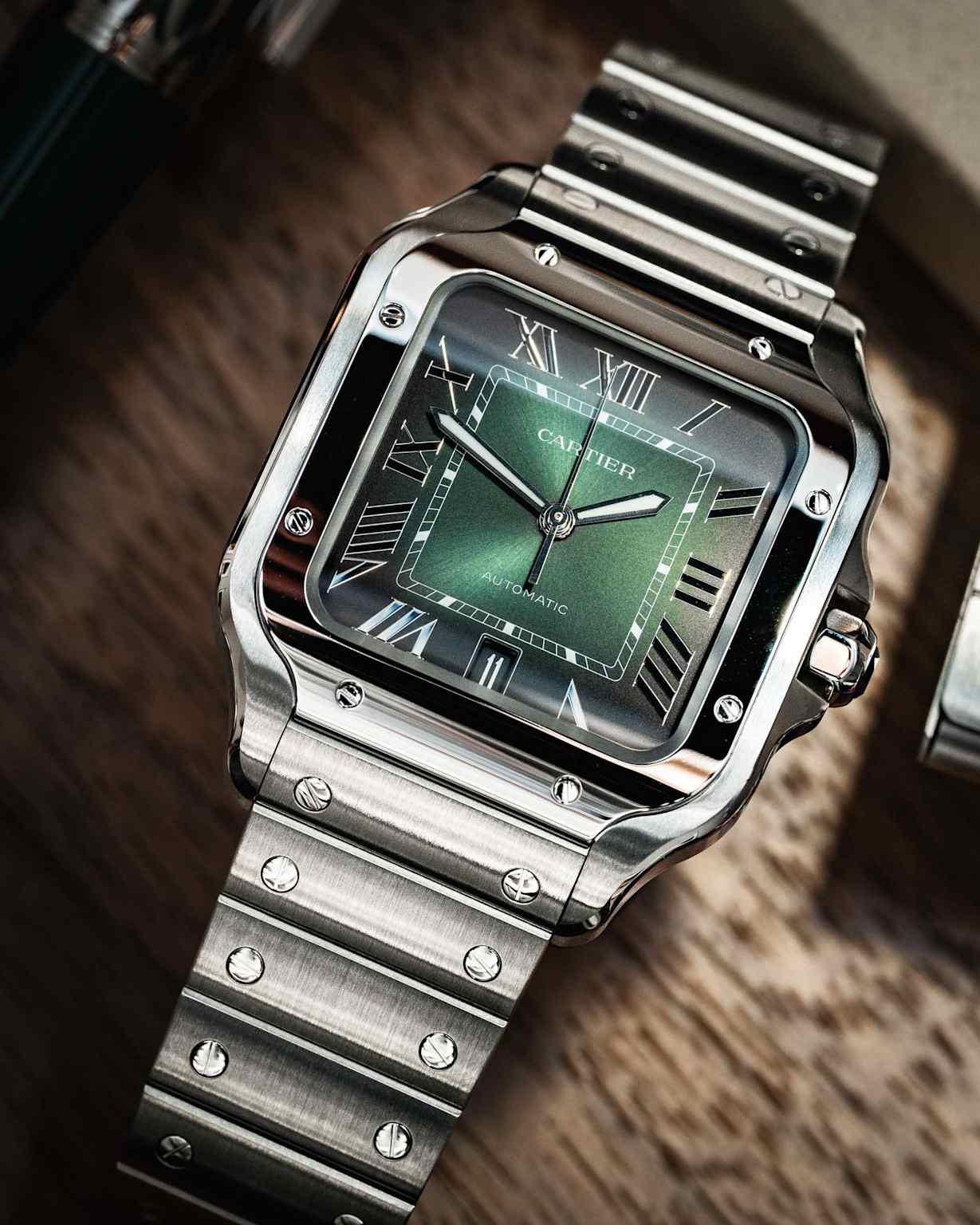
A detailed view of a Cartier Santos de Cartier watch with a green gradient dial and a stainless steel bracelet
The Santos represents an excellent balance of brand prestige and accessibility within the Cartier portfolio. While Cartier’s jewelry heritage commands respect globally, the Santos offers entry into this prestigious brand at a more approachable price point than complications or precious metal models. The watch’s historical significance as the first men’s wristwatch provides compelling conversation value alongside its undeniable aesthetic appeal.
Tudor Pelagos: Professional Diving Excellence
Tudor’s relationship with professional diving dates back to 1954 with the introduction of the Oyster Prince Submariner, establishing the brand as a serious player in tool watch manufacturing. The Pelagos, launched in 2012 and refined in subsequent years, represents the pinnacle of Tudor’s diving watch expertise, incorporating decades of feedback from military and professional users.

A close-up view of the Tudor Pelagos dive watch with a blue dial, titanium case, and a blue fabric strap
The French Navy played a crucial role in Tudor’s diving watch development, with the Marine Nationale using Tudor timepieces for underwater operations from the 1960s through the 1980s. This practical heritage informs every aspect of the Pelagos design, from its robust titanium construction to its helium escape valve and unidirectional rotating bezel.
Key Specifications:
- Case Material: Grade 2 titanium with Grade 5 titanium caseback
- Movement: Automatic Caliber MT5612 with 70-hour power reserve
- Case Size: 39mm diameter (Pelagos 39) or 42mm (standard Pelagos)
- Functions: Hours, minutes, seconds, date, diving bezel
- Water Resistance: 500 meters (professional diving capability)
- Price Range: $3,300 – $5,000 depending on model and configuration
The Pelagos 39, introduced in 2023, addresses the growing preference for smaller case sizes while maintaining full professional diving capabilities. This model offers the perfect balance of tool watch functionality and everyday wearability, making it equally suitable for boardroom and underwater environments.
Titanium construction provides exceptional strength-to-weight ratio, making the Pelagos significantly lighter than comparable steel diving watches while offering superior corrosion resistance. The patented self-adjusting bracelet accommodates wetsuit use and temperature changes, demonstrating Tudor’s attention to real-world diving applications.
Grand Seiko emerged in 1960 with an ambitious goal: creating mechanical watches that would exceed Swiss chronometer standards. This Japanese manufacturer has consistently delivered on that promise, developing innovative movements and finishing techniques that challenge traditional Swiss dominance in luxury watchmaking.
Grand Seiko: Japanese Precision Excellence

Grand Seiko Heritage Ginza Limited Edition watch featuring a light blue, city-grid patterned dial and stainless steel case
The brand’s philosophy centers on the pursuit of perfection through traditional Japanese craftsmanship combined with cutting-edge technology. Grand Seiko’s Spring Drive movement represents a unique hybrid approach, combining the soul of mechanical watchmaking with the precision of quartz regulation, achieving accuracy within ±1 second per day.
Key Specifications:
- Case Material: Stainless steel with exceptional hand-finishing
- Movement: Various options including Hi-Beat 36,000, Spring Drive, and GMT variants
- Case Size: Typically 39-40mm for optimal wearability
- Functions: Time, date, often GMT or power reserve indication
- Water Resistance: 100-200 meters depending on model
- Price Range: $2,800 – $4,500 for most models

A Grand Seiko Heritage Hi-Beat watch featuring a patterned dark dial and a stainless steel case and bracelet
Grand Seiko’s dial work represents some of the finest craftsmanship available at any price point, with nature-inspired textures and patterns that demonstrate exceptional attention to detail. The brand’s Zaratsu polishing technique creates mirror-like surfaces that rival or exceed Swiss finishing standards, often at significantly lower prices than comparable European alternatives.
From an investment perspective, Grand Seiko represents exceptional value in the current market. While the brand lacks the immediate recognition of Swiss counterparts, knowledgeable collectors increasingly appreciate its technical superiority and finishing quality. This presents an opportunity for savvy buyers to acquire world-class timepieces before broader market recognition drives prices higher.
Nomos Glashütte: German Bauhaus Elegance
Nomos Glashütte represents the renaissance of German watchmaking following reunification in 1990. Founded by Roland Schwertner just two months after the fall of the Berlin Wall, Nomos established itself in the historic watchmaking town of Glashütte, drawing on 175 years of regional horological heritage.
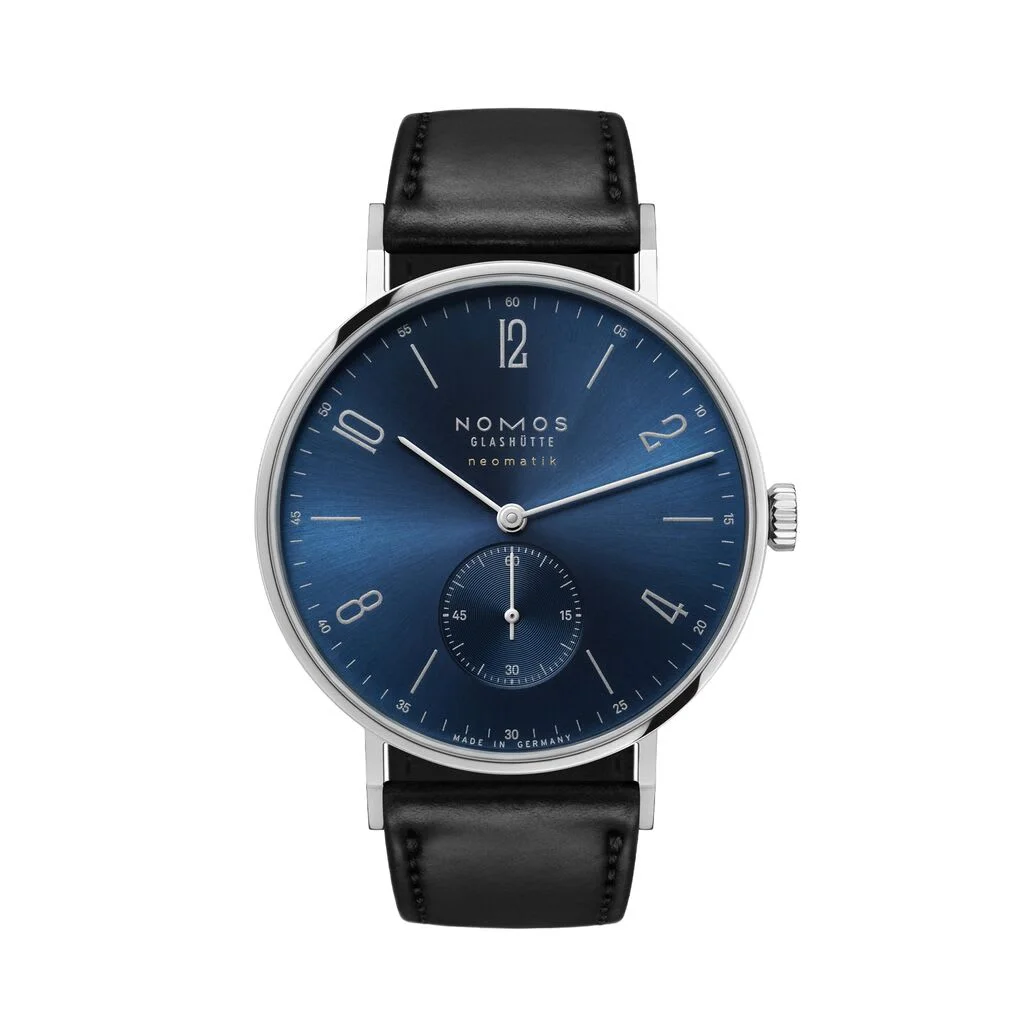
A Nomos Glashütte Tangente Neomatik watch with a deep blue dial and minimalist Bauhaus design on a black leather strap
The brand’s design philosophy draws heavily from the Bauhaus movement, emphasizing clean lines, functional beauty, and understated elegance. This aesthetic approach results in timepieces that feel simultaneously timeless and contemporary, appealing to collectors who appreciate subtlety over ostentation.
Key Specifications:
- Case Material: Stainless steel with refined brushed and polished finishes
- Movement: In-house manufacture calibers including proprietary escapement
- Case Size: 35-40mm range accommodating various preferences
- Functions: Time, small seconds, often date or power reserve
- Water Resistance: 30-100 meters depending on model
- Price Range: $1,800 – $3,200 for most models
Nomos achieved a significant milestone with the development of its proprietary escapement, the DUW 3001, making it one of the few manufacturers capable of producing this critical component in-house. This achievement represents genuine technical independence and allows Nomos to control quality while reducing dependence on Swiss suppliers.
The brand’s commitment to German manufacturing extends beyond mere assembly, with up to 95% of component value produced in Glashütte. This level of vertical integration, rare among brands at this price point, ensures consistent quality and supports the local watchmaking community.
Comparative Analysis: Materials, Value, and Positioning
Material Comparison: Steel vs. Titanium vs. Two-Tone
Understanding case materials significantly impacts both daily experience and long-term satisfaction with luxury timepieces. Each material category offers distinct advantages and considerations for prospective buyers.
Stainless Steel remains the gold standard for luxury sports watches, offering excellent durability, refined aesthetics, and proven track record in the market. Modern luxury watches typically utilize 316L or 904L stainless steel grades, with 904L offering superior corrosion resistance and a brighter finish. Steel watches provide substantial heft that many collectors appreciate, creating a sense of quality and presence on the wrist.
Titanium has gained prominence among luxury manufacturers due to its exceptional strength-to-weight ratio and superior corrosion resistance. Titanium watches weigh approximately 40% less than steel equivalents while maintaining equal or superior durability. This material particularly appeals to active individuals and those who prefer lighter timepieces for extended wear.
Two-Tone Construction combining steel with precious metals offers visual distinction and luxury appeal while maintaining steel’s practical benefits. However, two-tone watches require more careful maintenance and may show wear differently across the two materials.
| Material | Weight | Durability | Corrosion Resistance | Aesthetics | Maintenance | Cost Factor | Hypoallergenic | Best Use Case |
|---|---|---|---|---|---|---|---|---|
| Stainless Steel | Heavy (comfortable heft) | Excellent scratch resistance | Very Good | Classic, high polish possible | Moderate | Standard baseline | Good (316L grade) | Everyday luxury, formal wear |
| Titanium | Light (40% lighter than steel) | Excellent strength, prone to surface scratches | Excellent (superior to steel) | Modern, matte finish | Low (easy to maintain) | Premium (20–30% higher) | Excellent | Sports, diving, active lifestyle |
| Two-Tone (Steel/Gold) | Medium-Heavy | Good (varies by coating) | Good | Luxury, distinctive | Higher (two metals to care for) | Premium (25–40% higher) | Varies (steel component) | Special occasions, statement piece |
Value Retention and Investment Considerations
The luxury watch market demonstrates clear patterns in value retention that informed collectors can leverage when making purchasing decisions. Data from major secondary market platforms reveals significant variation in brand performance over the past five years.
High-Retention Brands like Omega and Cartier have demonstrated strong value stability, with Omega showing +27.81% appreciation and Cartier achieving +39.06% over the five-year period ending in 2024. These brands benefit from strong heritage, consistent quality, and broad market recognition that supports resale values.
Emerging Value Propositions represented by brands like Grand Seiko offer exceptional quality-to-price ratios that suggest potential for future appreciation as market recognition increases. While these brands may not command immediate premiums, they provide excellent value for collectors prioritizing craftsmanship over brand prestige.
Tool Watch Appeal exemplified by Tudor demonstrates the importance of practical heritage and professional credentials in maintaining value. While Tudor experienced some depreciation (-9.54%) during the broader market correction, models with strong military or professional connections tend to maintain better value stability.
Brand Prestige vs. Practical Value
Understanding the distinction between brand prestige and intrinsic value helps collectors make informed decisions aligned with their priorities and budget constraints.
Heritage-Driven Value benefits watches like the Omega Speedmaster and Cartier Santos, where historical significance creates emotional appeal that transcends pure mechanical specifications. These timepieces offer compelling stories that enhance ownership satisfaction and social recognition.
Technical Excellence represented by brands like Grand Seiko and Nomos provides exceptional mechanical value for collectors who prioritize craftsmanship and innovation over brand recognition. These watches often deliver superior finishing and movement quality compared to more expensive Swiss alternatives.
Balanced Positioning exemplified by Tudor offers professional credentials and Swiss heritage at accessible pricing, creating broad appeal among both enthusiasts and casual collectors.
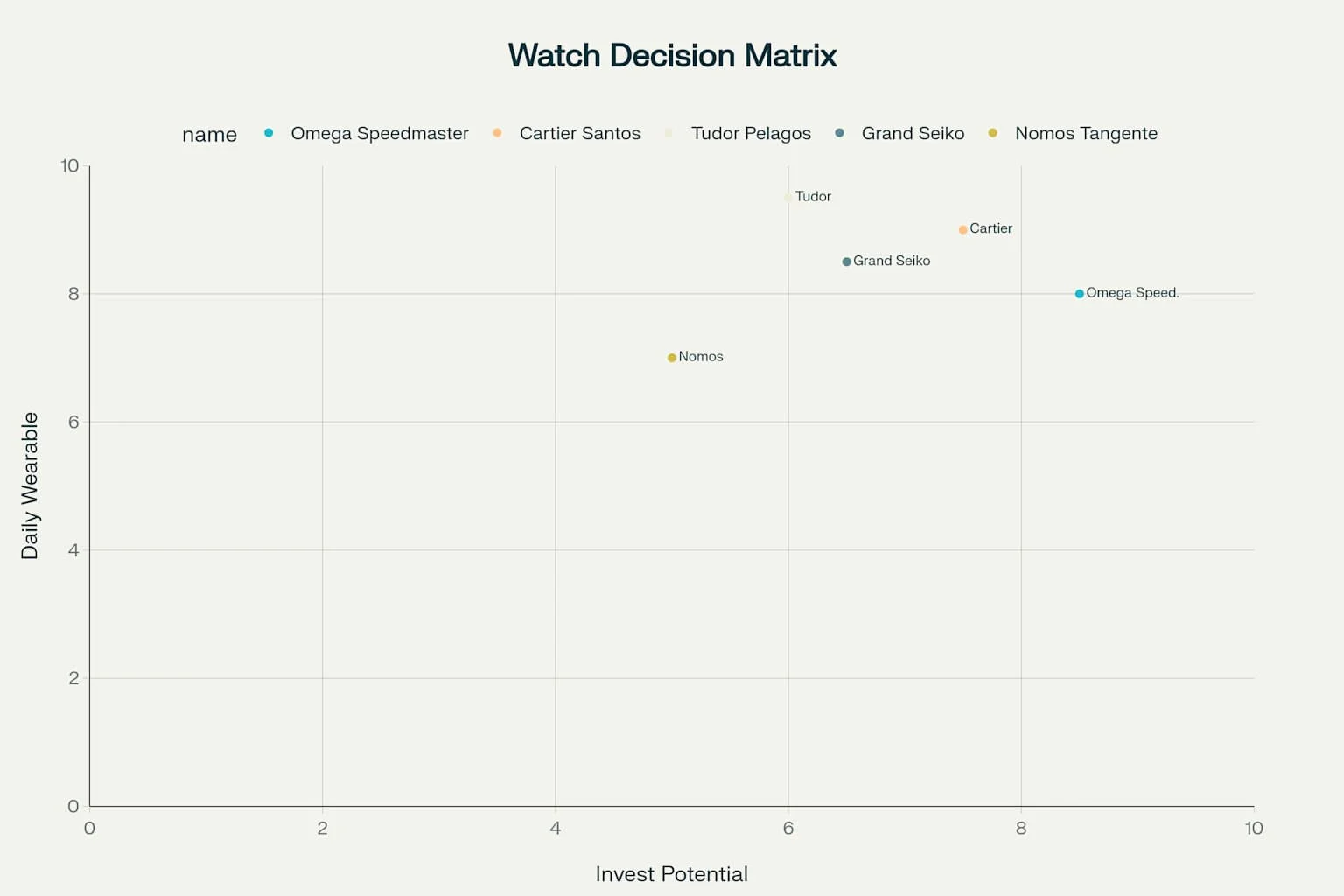
Market Trends Shaping the Sub-$10,000 Segment in 2025
Growing Entry-Level Luxury Market
The sub-$10,000 luxury watch segment has experienced remarkable growth, driven by several converging factors that benefit both new and experienced collectors. Market research indicates this segment has grown 15-20% year-over-year, significantly outpacing other luxury categories.
Demographic Shifts play a crucial role in this expansion. Younger collectors, particularly millennials and Gen Z buyers, approach luxury watches differently than previous generations. They prioritize authenticity, sustainability, and value over pure status, creating demand for well-crafted timepieces with genuine heritage rather than ostentatious displays of wealth.
Improved Accessibility through online platforms and authentication services has democratized luxury watch collecting. Buyers can now research, compare, and purchase timepieces with confidence, while secondary market platforms provide transparency in pricing and condition assessment.
Educational Resources including online communities, YouTube channels, and specialized publications have created more informed consumers who understand value propositions and can distinguish between marketing hype and genuine quality.
Price Evolution and Value Positioning
The luxury watch industry has undergone significant price repositioning in recent years, with entry-level luxury pricing moving from the traditional $5,000 baseline toward $8,000. This shift reflects several factors including material costs, enhanced manufacturing standards, and strategic brand positioning.
Quality Improvements justify higher entry prices through enhanced movements, better materials, and superior finishing. Modern $8,000 watches often deliver quality levels that previously required $12,000-15,000 investments.
Supply Chain Optimization has allowed mid-tier brands to incorporate previously exclusive features like in-house movements, silicon components, and advanced anti-magnetic properties without reaching ultra-luxury pricing.
Market Maturation has created more sophisticated buyers who understand value propositions and willingly pay appropriate premiums for genuine quality improvements.
Secondary Market Dynamics
The pre-owned luxury watch market has evolved into a sophisticated ecosystem that benefits both buyers and sellers through enhanced transparency and authentication services. This market now represents over $26 billion globally and continues expanding rapidly.
Authentication Technology has largely eliminated concerns about counterfeit timepieces in the legitimate secondary market. Professional platforms now offer comprehensive verification services that provide buyer confidence while maintaining seller accountability.
Price Discovery has become more efficient through online platforms that aggregate pricing data and transaction history. This transparency benefits buyers through competitive pricing while ensuring sellers receive fair market value.
Liquidity Improvements make luxury watches more attractive as alternative investments, as collectors can more easily buy and sell timepieces when circumstances change or interests evolve.
Buyer’s Guide: Choosing Your Perfect Luxury Watch
Decision Framework: Matching Watches to Lifestyle Goals
Selecting the right luxury watch requires honest assessment of personal priorities, lifestyle demands, and long-term objectives. Consider these key factors when evaluating potential purchases:
Primary Use Case significantly influences optimal choice:
- Daily Office Wear: Prioritize comfort, versatility, and refined aesthetics
- Active Lifestyle: Emphasize durability, water resistance, and robust construction
- Special Occasions: Focus on visual impact, brand recognition, and formal appropriateness
- Investment Collecting: Target heritage brands with strong secondary market performance
Size and Comfort Considerations have become increasingly important as case size preferences trend toward more moderate dimensions. The 39-42mm range represents the current sweet spot for versatility and comfort.
Budget Allocation Strategy should account for total cost of ownership including potential service costs, insurance, and accessories. Generally, plan for 10-15% of purchase price in maintenance costs over the first decade.
Essential Checklist for First-Time Luxury Watch Buyers
Before Purchase:
- Try the watch on your wrist for at least 10 minutes to assess comfort
- Verify authenticity through authorized dealers or certified pre-owned programs
- Research service history and availability of parts/service
- Understand warranty coverage and limitations
- Compare pricing across multiple sources for fair market value
Technical Verification:
- Confirm movement type matches your preferences (automatic vs. manual)
- Verify water resistance meets your activity requirements
- Check power reserve duration for automatic movements
- Assess accuracy specifications and expectations
- Review available strap/bracelet options for versatility
Long-Term Considerations:
- Research brand’s service network and costs
- Understand depreciation patterns for similar models
- Consider insurance requirements and costs
- Evaluate upgradeability and collection strategy
- Plan for proper storage and maintenance equipment
Investment vs. Enjoyment Balance
Successful luxury watch ownership requires balancing investment considerations with personal enjoyment and satisfaction. The finest timepieces reward their owners through daily use rather than safe storage.
Investment-Focused Approach suits collectors who view watches primarily as alternative assets. These buyers should prioritize:
- Established brands with proven track records
- Limited production models with historical significance
- Exceptional condition and complete documentation
- Strong secondary market liquidity
Enjoyment-Focused Approach emphasizes personal satisfaction and daily utility. These buyers should consider:
- Comfort and wearability for intended use
- Aesthetic appeal and emotional connection
- Practical features matching lifestyle needs
- Service accessibility and reasonable maintenance costs
Balanced Strategy combines investment awareness with personal enjoyment, allowing collectors to appreciate their timepieces while maintaining value. This approach often yields the highest long-term satisfaction regardless of market performance.
| Model | Price Range (USD) | Case Material | Case Size | Movement Type | Water Resistance | Key Heritage | Investment Appeal |
|---|---|---|---|---|---|---|---|
| Omega Speedmaster Professional | $4,000 – $8,500 | Stainless Steel | 42mm | Manual Chronograph | 50m | Moon Landing 1969 | High – Moon Legacy |
| Cartier Santos de Cartier Large | $6,000 – $8,500 | Stainless Steel / Two-tone | 39.8mm x 35.1mm | Automatic | 100m | First Men’s Wristwatch 1904 | Medium-High – Iconic Design |
| Tudor Pelagos 39 | $3,300 – $5,000 | Titanium Grade 2 | 39mm | Automatic | 500m | French Navy Heritage | Medium – Tool Watch Appeal |
| Grand Seiko SBGM221 | $2,800 – $4,500 | Stainless Steel | 39mm | Automatic GMT | 100m | Japanese Precision Craft | Medium – Undervalued Quality |
| Nomos Tangente 38 | $1,800 – $3,200 | Stainless Steel | 38mm | Manual Wind | 30m | German Bauhaus Design | Low-Medium – Design Focus |
Excellence Within Reach
The luxury watch market under $10,000 in 2025 offers unprecedented opportunities for discerning collectors to acquire timepieces that combine exceptional craftsmanship, rich heritage, and strong value propositions. Whether drawn to the space-tested legacy of the Omega Speedmaster, the pioneering spirit of the Cartier Santos, the professional credentials of the Tudor Pelagos, or the technical excellence of Grand Seiko and Nomos alternatives, today’s buyers can access world-class horology without requiring six-figure investments.
Success in this market segment requires understanding that true luxury lies not in ostentatious display but in the intersection of heritage, craftsmanship, and personal satisfaction. The finest watches reward their owners through decades of reliable service, evolving from mere accessories into treasured companions that mark life’s significant moments.
As the market continues maturing and new collectors enter the field, these carefully selected timepieces represent not just excellent value propositions but gateway experiences into the broader world of horological appreciation. Choose wisely, wear proudly, and enjoy the journey into one of humanity’s most enduring and rewarding pursuits.
